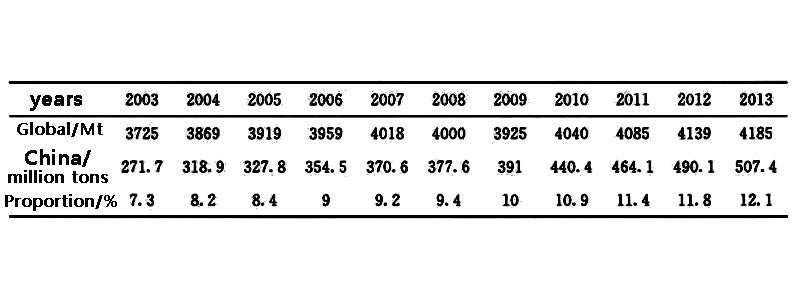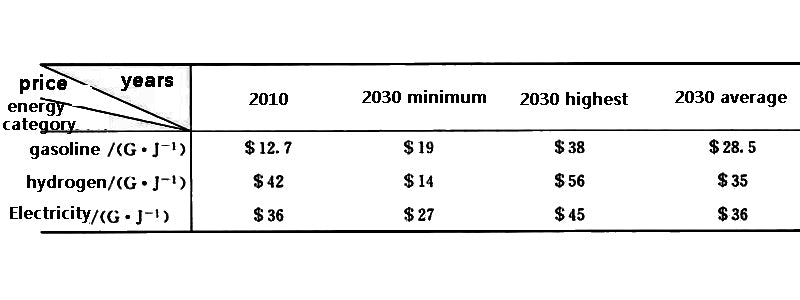
With the continuous progress of society and the rapid development of economy, the problems of global energy shortage and environmental pollution are becoming more and more serious. Energy and environmental issues have become strategic issues that endanger national security and directly affect human health and survival. Conserving and developing clean energy, improving energy efficiency, protecting and improving the environment, and promoting comprehensive, coordinated and sustainable economic and social development have become the common responsibility of the international community.
Affected by the financial crisis, global oil consumption declined slightly in 2008 and 2009, but then rebounded in 2010, reaching 4.185 billion tons in 2013. China is the country with the fastest growth in oil consumption. In 2013, oil consumption exceeded 500 million tons for the first time, reaching 507.4 million tons, of which about 283 million tons of imported crude oil were imported, with a foreign dependence rate of 55.77%. It is estimated that by 2020, China's dependence on foreign oil will reach 56% to 60%. Table 1 shows the oil consumption from 2003 to 2013.

Table 1 Oil consumption from 2003 to 2013
As a resource-intensive and energy-consuming industry, the transportation industry accounts for about 50% of global oil consumption, and 95% of private transportation depends on oil. In China, the proportion of transportation energy consumption in the total social energy consumption has increased from 5% in 1980 to 20% in the past two years, and the annual oil consumption accounts for 50% of China's total oil consumption, while the per capita oil recoverable reserves Only 11% of the world average. By the end of 2010, the cumulative proven geological reserves of PetroChina were 31.28 billion tons, which can only be recovered for 15 years. At the same time, China has become the second largest oil consumer after the United States. With the continuous improvement of China's oil dependence on foreign countries, oil safety will become an important factor restricting economic and social development. In addition, the greenhouse gases and pollutants emitted with the energy consumption of the transportation industry, such as carbon dioxide, dust, sulfides, nitrogen oxides and polycyclic aromatic hydrocarbons, are the root causes of environmental pollution and various human diseases. Taking the United States as an example, 28% of the annual greenhouse gas emissions come from the transportation industry, of which 34% of carbon dioxide emissions come from the transportation industry, and 36% to 78% of the major urban gas pollutants come from the transportation industry. Accounting for 68% of China's oil consumption, these numbers will continue to grow if left unchecked.

Energy consumption in the transportation industry
An important factor that makes electric vehicles, hybrid vehicles and fuel cell vehicles difficult to popularize in private cars today is their high energy prices. Offer and others forecast the prices of gasoline, hydrogen, and electricity in 2030. The forecast results are shown in Table 2. Although this forecast may not be very accurate, with the development of science and technology, the cost of hydrogen production technology and power generation technology has decreased. , the price difference between gasoline, hydrogen and electricity will become smaller and smaller. This will prompt private car users to pay more attention to the new energy vehicle industry.

Table 2 Comparison of three energy prices in 2010 and 2030
Under the dual pressure of energy crisis and environmental problems, in recent years, countries around the world are actively formulating energy development strategies, seeking effective ways to balance energy supply, saving energy and developing new and renewable energy. Taking into account the expected demand for oil consumption due to the rapid growth of the automobile market, China has begun to formulate automobile fuel consumption standards since 2001, and in 2004 issued the first national standard "Passenger Vehicle Fuel Consumption Limits". Up to now, China has implemented a number of energy policies for energy conservation and emission reduction. The U.S. government has also formulated many transportation policies, such as limiting vehicle mileage, reducing vehicle drag consumption, improving vehicle engine technology, and developing low-carbon and non-fuel-efficient power systems. EU countries attach great importance to energy conservation and emission reduction, and have formulated a series of environmental protection policies. They plan to cut the number of fuel vehicles in urban traffic by about half by 2030, and completely stop fuel vehicles in urban traffic by 2050. Japan began to implement the "green tax system" in 2009, and has made significant adjustments in gasoline tax, automobile consumption tax, and the weight of traditional fuel vehicles. The applicable objects include pure electric vehicles, hybrid vehicles, clean diesel vehicles, and natural gas vehicles. As well as vehicles certified for low emissions and low fuel consumption. Nevertheless, the energy saving potential of the transportation industry is still huge, and there is still a long way to go.
















